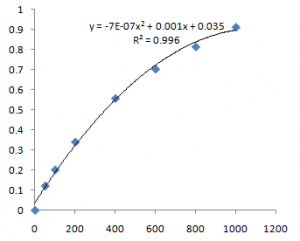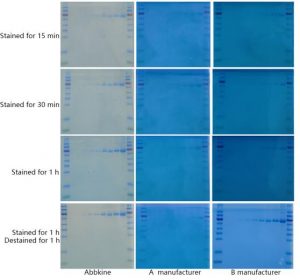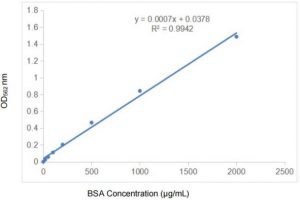Protein Quantification Topic|What protein quantification methods have you used over these years?
Protein quantification is an important step that must be taken before protein isolation and analysis, protein chromatography separation, protein electrophoresis analysis, protein immunosegregation and analysis, total protein quantification of cell split interpretation, labeling of protein molecules, protein structure analysis, etc., all need reliable quantitative analysis as the basis. The fields of application of protein quantification analysis include biological sciences, food testing, clinical testing, and more. Specifically, we need to use protein quantification experiments in the following scenarios:
1. When judging whether the protein is expressed, first lyse the cells to verify whether the cell lysis is thorough, or to carry out the usual experiment or standardized preservation of the sample, then the cell lysate should be quantified for protein;
2. To determine the expression of protein and the yield, it is necessary to quantify the purified protein;
3. Purified protein for the next application, such as labeling the reporter enzyme or biotin, etc., also need to quantify the protein first in order to calculate the optimal working concentration of the reagent.
Let's take stock of some of the most common protein quantification methods today:
Ⅰ. Ultraviolet method
The ultraviolet method is also one of the commonly used protein quantification methods, which can quantitatively determine the amount of protein in the solution in a simple spectrophotometer. Protein absorption of near-ultraviolet light depends on tyrosine (Tyr) and tryptophan (Trp) levels, and to a small extent is also affected by the number of phenylalanine (Phe) and disulfide bonds. Therefore, the absorption values of A280 between proteins vary greatly, and for solutions with concentrations of 1 mg/mL, there are values from 0 to 4, and the absorption values of most proteins range from 0.5 to 1.5.
Ⅱ. Bradford method
1.Coomassie bright blue colorimetry (e.g. KTD3002)
Coomassie bright blue G250 is an organic dye, red in the free state, its maximum absorption peak at 465nm, in the diluted solution with the protein's alkaline amino acids (especially arginine) and aromatic amino acids after binding to blue, this binding has high sensitivity, at this time the absorption peak also changed from 465nm to 595nm, in a certain range, optical density and protein content is linear relationship. Therefore, it can be used for the determination of protein content. Its features are as follows:
Save time—color development almost immediately
Compatibility—Independent of most chemicals, the concentrations of thioghanol and dithiothreitol in the sample can reach 1 mM and 5 mM, respectively
Wide detection range—50-1000 ug/ml operating range
Cost-effective — good price-performance ratio, single experiment, lower cost.

Fig.1 Protein Quantification Kit (Bradford Assay) standard curve
2.Coomassie bright blue staining (e.g., BMU105-EN)
Coomassie Brilliant Blue is a common dye used for the visualization of proteins (separated by protein gel electrophoresis). Under acidic conditions, Coomassie bright blue binds to the basic and hydrophobic amino acid residues of proteins, and the color appears dark blue.

Fig.2 SuperKine™ Protein Gel Fast Staining Solution (Coomassie Blue) was used to stained BSA and compared with staining solutions from A manufcturer and B manufcturer.
Ⅲ. BCA method(e.g., KTD3001)
The BCA (Bicinchoninic acid) method is a recently widely used method of protein quantification. The principle is similar to lowary protein quantification, that is, in the alkaline environment, the protein merges with the Cu2+ complex to reduce Cu2+ to Cu1+. BCA binds to Cu1+ to form a stable violet-blue complex with a high light absorption value at 562 nm and is proportional to the protein concentration, according to which the protein concentration can be determined. Its features are as follows:
- Save time—fast color rendering
- Good compatibility — not affected by most chemicals. For compatible concentrations of thioghanol and dithiothreitol in the sample, up to 0.01% and 1 mM, respectively.
- Good detection range — detection range from 20 to 2000ug/ml.

Fig.3 Abbkine Protein Quantification Kit (BCA Assay) standard curve.
The above is a "total quantification" for whole proteins, however many experiments require quantitative analysis of specific proteins in solution, that is, "individual quantification" of specific proteins. Commonly used methods for quantification of specific proteins are enzyme-linked immunosorbent assay (ELISA), western blot analysis (WB), and mass spectrometry (MS).
1.ELISA law (such as KET6038, KET6039)
ELISA is a common method for quantification of specific proteins in solution, usually performed on 96-well microplate plates, with the key step being fixation of specific antigens/proteins. Specifically, there are different variants of ELISA. Commonly used ELISA methods are the bi-antibody sandwich method, the former for the detection of macromolecular antigens, and the indirect method for the determination of specific antibodies. ELISA is a reliable technique widely used to detect antigen content in samples. With Abbkine's ELIKINE kit, accuracy and reliability are greatly improved.
2.WB (such as KTD106-CN)
WB is generally suitable for semi-quantitative. The original or denatured proteins are separated by gel electrophoresis, the proteins are transposed (nitrocellulose or PVDF), and then detected using specific microplate label antibodies. Finally, an appropriate substrate (chemiluminescent substrate) is added to produce a detectable signal. Although WB is more time-consuming than ELISA, WB can not only quantify specific proteins, but also detect protein modifications simultaneously in experiments. Use Abbkine's Universal Western Blotting (WB) toolbox to meet your routine WB assay needs and get excellent results from a single source.
3、MS
MS is an emerging method for protein quantification. In proteomic analysis, in addition to protein characterization, an important step is the quantification of specific proteins. There are many ways to quantify proteins in MS.
A commonly used method is to add heavier stable isotopes carbon (13C) or nitrogen (15N) to the first sample (polypeptide or protein), while the corresponding light isotopes (12C and 14N) are added to the second sample (internal standard) and then mix the two samples for analysis. Due to the difference in quality between the two samples, the ratio of the peak intensity of the two samples measured with a mass spectrometry analyzer is equivalent to their relative abundance ratio.
The second method of mass spectrometry protein quantification can be performed without labeling the sample, i.e., with matrix-assisted laser desorption/ionization-MALDI analysis. Using mass spectrometry, a universal method, it is possible to perform both quantitative and qualitative detection in a single experiment. However, this method requires expensive detection instruments, which limits the use of this method.
Related product recommendations are as follows:
| Product NO. | Product Name | Application | Sizes | Price |
| KET6038 | EliKine™ Human Carcinoembryonic Antigen (CEA) ELISA Kit | ELISA | 48T/96T | $259/359 |
| KET6039 | EliKine™ Human Prostate Specific Antigen (PSA) ELISA Kit | ELISA | 48T/96T | $259/359 |
| KTD3001 | Protein Quantification Kit (BCA Assay) | Protein Quantification-BCA | 500T/2500T | $69/169 |
| KTD3002 | Protein Quantification Kit (Bradford Assay) | Protein Quantification-Bradford | 500T/2000T/5000T | $39/89/149 |
| BMU105-EN | SuperKine™ Protein Gel Fast Staining Solution (Coomassie Blue) | Gel staining | 250mL×2 | $59 |
| KTD106-EN | Universal WB Toolkit | WB | 20T | $59 |
There are many more techniques for protein quantification, which are widely used in a wide range of fields, and play a pivotal role in the development of the biological industry, and are continuing to gain the attention of biological scientists.
Welcome to Abbkine public account, there will be more scientific surprises waiting for you. At the same time, Abbkine technical experts in order to provide readers with a platform to learn biological knowledge, through unremitting efforts, will be a variety of high-end biological experiments out of dry goods, later published in Abbkine website, please love science readers continue to pay attention to Abbkine public number.
Abbkine focuses on proteomics and cytology and is committed to the innovation and development of antibodies, proteins, analytical reagents and kits to become a key enabler of life science research and development, drug discovery and other fields. We provide you with the most popular products for the users of protein and immunology research, from the basic immunology products, such as protein extraction quantification, to internal reference labeled antibodies, primary antibodies and secondary antibodies for immunology experiments. Cell research users' favorite products, from dyes and kits for cell state detection, organelle extraction kits, cell substructure staining tracer and cell metabolism detection products, to cytokines and protein detection kits for cell culture, just to help your research career!











